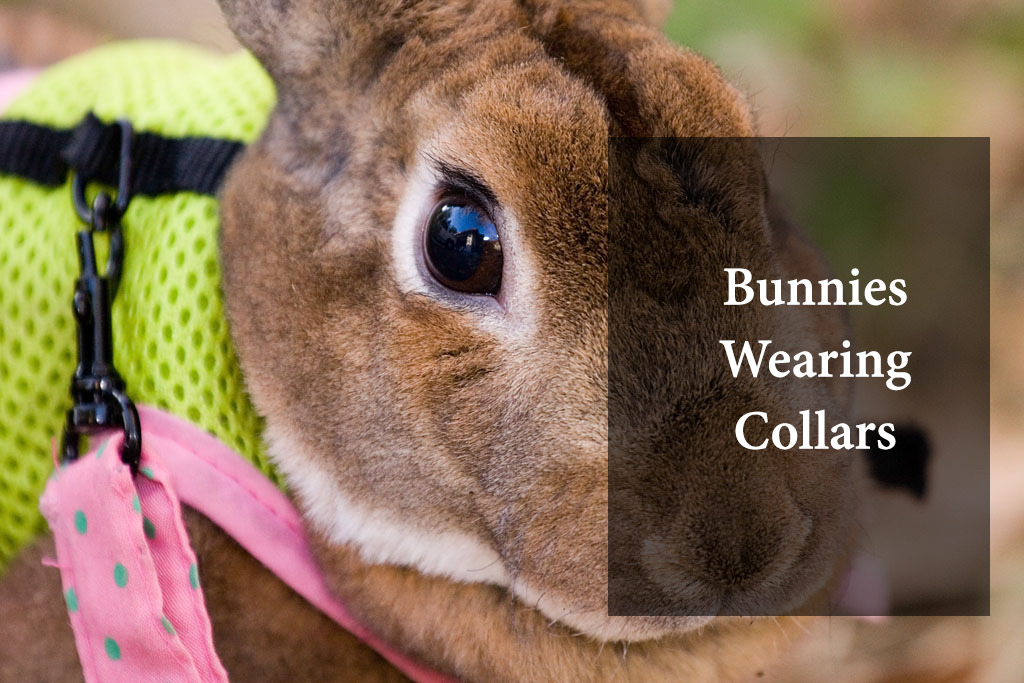Rabbits often roam aimlessly. It is possible that they may become lost or injured. As such, just like many other domesticated animals, it is advisable to put an identification collar around the rabbit’s neck. But are they safe?
Before we can discuss whether rabbits should wear identification tags or not, let us first establish if these pets can actually don collars in the first place. This has been a long-standing debate among rabbit owners.
So the question is Can a rabbit wear a collar?
A collar is more than just some cute accessory your pet can put on. It can be seen as a safety measure and also aids in connecting a leash on your dog when taking them for a walk. There are various reasons why an owner might want to consider putting a collar over their rabbits’ necks.
You indeed love your bunnies and you would do anything to protect them but this could be dangerous for them by causing injury or even killing. In this blog post will discuss the dangers of using collars for your bunnies and alternatives to apply instead. The security of your rabbit ranks paramount.
Why is wearing a collar not safe for bunnies?
Some reasons make a collar unsafe for your rabbits. Firstly, it might be startled leading to a sudden jump of the rabbit. It can potentially lead to the trapping of your bunny in any object. This is dangerous to rabbits since it causes strangulation or breaking of their necks.
Also, having them collared could be another danger when they try and pull it off. Most rabbits will spend all day trying to get rid of these collars, and they can sometimes get their feet or mouths caught in them by accident. In case you are absent, this could make your bunny feel anxious which often results in serious matters.

Rabbit’s fur around the neck region is very thin and tender; thus a collar can rub away the fur surrounding the neck area and bring about abrasions- skin lesions caused by friction with something hard or rough on the skin. The skins and spines of a rabbit are extremely sensitive. Therefore wearing a collar around their neck would not be advisable at all.
Key takeaways
While popping a collar on a rabbit’s neck seems harmless, there are related problems and dangerous scenarios. You must know about these:
👉 Rabbits could get stuck.
👉 Collars can rub and harm rabbit’s skin.
👉 They could get stuck on the collar itself.
What about breakaway collars?
Putting breakaway collars on cats and dogs is common to avoid strangulation problems. But here one question arises Can breakaway collars also work for rabbits?
Basically, break-away collars work by snapping open easily when they get snagged.
This prevents pet animals from being strangled. In case your rabbits get their feet or mouths stuck in the collar, this feature of breakaway collars might not be useful because the pressure is not strong enough to snap it open.
There’s also a risk of bunnies escaping. When you’re walking with your rabbits and something startles them and they lunge away, the collars could open, which can allow your rabbit to run away and as a result of it, you might lose your rabbits.
These collars, however, are not meant for leash walking. A harness has to be employed in order to walk the rabbit so you should ensure that the harness is worn just during walks. Furthermore, this type of collar is used only to keep pets identifiable but not for restraining a lease walk or whatever else.
Use this guide to collar-train your rabbits
👉 Use the right equipment
To make collar training successful, it is important you use the right equipment. Therefore, a comfortable and adjustable neck collar and a light leash that is simple to handle should be sought.
👉 A slow start
You should gradually introduce the collar to your rabbit by allowing it to play with the collar and leash. You can also give your rabbits some treats to encourage them.
👉 Introduce the collar
Easily put the collars on the rabbit’s neck and always try to keep them loose.
👉 Praise your rabbit
Pet your rabbit for their cooperation while in the collar. Reward them with tasty snacks for being courageous.
👉 Take them on a walk
Take them for short walks using the leash after they have accepted wearing the collars.
👉 Increase walking time
Increase the distance of walking gradually so that your rabbit gets used to wearing collars.
👉 Keep patience
Collar training requires patience and time. So don’t rush it.
👉 Monitor your rabbit’s behavior
Watch how the rabbit acts when wearing a collar. In case they appear disturbed, take a rest and retry after a few days.
👉 Have fun!
Have an incredible enjoyment while training rabbits on how to wear collars. Ensure there are many eatables that act as incentives.
What about bells on rabbit’s collars?
Is a bell necessary in a rabbit’s collar when it is outside? Here are some reasons why you might want to add a bell to your rabbit’s collar:

👉 A bell can help you keep track of the whereabouts of your bunnies
Rabbits can play and hide under things, and they are small enough that they can be easily lost. This makes it easy for you to know where your bunnies are by joining the bell on their necks. It means that your animals are out of danger.
👉 In a multi-rabbit household
In case one rabbit usually bullies another, a tiny toy or bell around his neck could serve as a warning for weaker ones that he is approaching them and it would give them enough time to run away from that place.
However, Rabbits use bells on their collars as a signal to birds and other animals that could be predators which are around.
This problem arises because certain types of cats or dogs have natural hunting instincts causing them to move without making noise or just shaking the bells gently. This one benefit alone may not be immediately clear. Not only that, if rabbits wear bells then many predators would know where they are located and this would endanger them.
Safe harnesses for rabbits
Rabbit safety harnesses are built to ensure their protection from danger. These include:
👉 H- harness
A type of harness that is extensively used for this purpose is the H-harness. They fit comfortably around a rabbit’s neck and waist. Unlike the common ones which put much pressure on their necks, these evenly distribute it throughout their bodies. Buckles on the neck and belly can be adjusted depending on the size of a particular rabbit.
👉 Vest harness
It is like a small vest. Many harnesses have Velcro at the neck and waist. Some other varieties include snaps or bum straps.
👉 Shoulder harness
The harness exerts pressure on the rabbit’s shoulder rather than just on their neck.
They fit over the shoulders and front legs. So while they’re more comfortable for the rabbit, they are more challenging to come by.
Unsafe harnesses
The harnesses that could cause physical harm to your rabbits are:
👉 Figure 8 harnesses
Several dangers are associated with using figure-8 harnesses which are meant for dogs, on rabbits as a result of anatomical and behavioral differences. Incorrect fitting of these harnesses may lead to pain, openings and fear among rabbits.
Also, such a prey animal can become highly fearful while in unfamiliar settings which worsens when it is restrained by an inappropriate-size harness. In addition, when the rabbit fights against the harness there will be an increased risk of hurting itself most especially its tender spine.
For outdoor activities to be safe for and ensure the well-being of rabbits, they need to wear appropriate harnesses that fit them perfectly and which will aid in mitigating the risks involved.
👉 Rope harnesses
Rope harnesses are designed for activities like climbing or for dog walking. The unsuitable texture of the harness may cause a skin rash or damage to the rabbit while it may not even hold tightly on the rabbit which increases its tendency to escape or get hurt in case it struggles.
It is important that rabbits are kept in stress-free environments as they are delicate animals otherwise their anxiety levels will worsen when they put on any other type of leash. Therefore, during activities outside, there is an absolute need to use properly designed leashes for rabbits.
FAQ
In what way can I keep my rabbit safe without using a collar?
Rabbits may be fitted with special harnesses instead of collars for safety. It enables firmer fastening without strain on the neck of the rabbit.
Why are collars considered to be dangerous for rabbits?
Collars pose a threat to rabbits because they are made up of very fragile structures. The pressure exerted by a collar around its throat may cause discomfort or injury when it strains against or jerks away from it.
What dangers do collars place on rabbits?
Collars may suffocate rabbits, leading to suffocation, choking, and even severe damage to the soft tissues in their necks.
Are there other ways apart from using a collar to confine rabbits?
Certainly, rabbit-specific harnesses make safer options. They distribute stress better throughout the animal’s body and lessen the chances of injuring the neck.
Do collars limit how a rabbit moves or behaves?
Yes, collars can inhibit movement as well as induce anxiety and distress that affects their conduct negatively.
Final words:
Collars are dangerous for you rabbit and that is a fact. It can cause damage to your rabbit and to avoid that you must do the thing suggested in the blog. As you can obviously see, there is no one answer that is right for everyone. You must decide to rely on your rabbit’s own make-up.
However, if your rabbit does go outside a bell might not work the way it was intended to work. If you wish to walk with your rabbit, then consider getting a rabbit harness and leashes. Ensure that the collar of your bunny is the correct size. While buying my pet a rabbit, I should buy them a good quality one.


